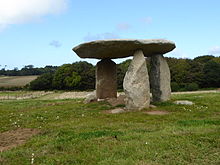Giant's Quoit
The Giant's Quoit (also called Carwynnen Quoit , Giant's Frying Pan , Pendarvis Quoit or Pendarves Quoit ) in Carwynnen near Camborne in Cornwall in England collapsed in the 19th century and again in the 1960s and was re-erected in 2012 and archaeologically examined at the same time.
description
The dolmen described by Edward Lhuyd around 1700 and by William Borlase in 1769 is about 1.5 m high with a capstone weighing about 10 tons that is about 3.3 m long, 2.5 m wide and 0.3 m thick.
The Giant's Quoit is one of the lesser-known Neolithic monuments that belong to the portal tombs , the dolmens found in Cornwall and Wales, as well as Ireland and Northern Ireland . There they are known as “tripod dolmens”.
During the last investigation, early Neolithic pottery (3900-3600 BC) was found. The vessels are usually undecorated, have wide openings, round bases and simple knobs as handles. Such early pottery is not often found.
literature
- John Barnatt: Prehistoric Cornwall: The ceremonial monuments. Turnstone Press, Wellingborough 1982, ISBN 0855001291 .
Individual evidence
- ↑ Giant's Quoit or The Giant's Table is also a name for the Lanyon Quoit
Web links
- Description pictures, video, location (English)
Coordinates: 50 ° 11 ′ 17.7 " N , 5 ° 17 ′ 36.1" W.

